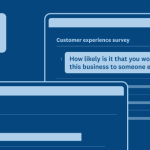This post was written by John Leech, Director of Talent Acquisition at St. Jude Children's Research Hospital.
Every talent acquisition leader (deservedly) thinks their job is important. At the end of the day, an organization’s success comes down to the people who make it up. But where I work at St. Jude Children’s Research Hospital, “success” has a whole different meaning—the people I hire help find cures and save children’s lives.
Because the work is so important, we want to offer highly talented people the best candidate experience we possibly can. But we also have a lot of applicants to contend with: in 2018, we received 53,000 applications to fill about 900 jobs. My job is to make candidates feel personally valued, at scale. I use surveys to help me do that.
How do we make each person feel supported at every step of our relationship with them? How do we ensure they have everything they need to envision a career at St. Jude? Are there missing pieces that are affecting the way these candidates see us?
When I came to St. Jude, we decided to start asking these questions directly—a strategy that’s paid off in dozens of different ways. And even though the stakes may be different for other companies, the principles we follow are universally applicable.
Guiding principles and rules of thumb
Never stop asking, measuring, and testing: We never viewed our candidate surveys as an audit. The idea isn’t to “fix” the process and then call it a day—our system is constantly evolving based on a diet of consistent feedback. I love the expression, “we reserve the right to get smarter,” and we really take it to heart. You never really “succeed” at hiring, because working conditions, preferences, org needs, and the market landscape are always in flux.
Be thoughtful about the details: Another principal that we take to heart is hospitality. We really want to treat every candidate like an honored guest, so we’re always looking to feedback to understand which parts of the experience candidates really appreciate and where we can add even more value. One simple thing we’ve started doing is sending candidates photos of the employee that will meet them for their onsite interview before they arrive, so they know who to look for. We also work with local hotels and restaurants to offer prepaid or discounted services to services to guests of St. Jude. Candidates have told us how much they appreciate these details, which encourages us to keep investing in them.
Treat every candidate as a brand ambassador, regardless of outcome. We want people who didn’t ultimately get hired to leave with the same positive experience as the people who did. We survey everyone—including people who left without an offer or an interview. And we weigh those people’s feedback just as heavily as the feedback from people we did hire! Everyone is a potential future candidate, and our reputation as a brand that cares for its guests is incredibly important to us.
How we use surveys with candidates
When I started, we didn’t really have any metrics. We had a process that worked, but no insight into how well it was working or where we could try something different. We also didn’t have much insight into how the candidate experience was changing over time.
So we embedded surveys into the entire candidate process. We send surveys to some candidates after their interviews, surveys to others after initial conversations, and surveys to some candidates after they’ve already learned whether or not they’ve gotten the offer.
Since then, we’ve learned a ton. A few of the changes we’ve made based on survey feedback:
- Many candidates expressed that Ubers would be more convenient than the yellow cabs we sponsor for travel during interviews and hospital visits. We decided to make the change.
- Because of our patients’ sensitive condition, we have extensive security in place at the hospital. As it turned out, those processes were delaying our job candidates—sometimes significantly. We were able to work out a special process with security so that candidates could bypass some of the normal processes and get into the engagement faster.
- We reimagined our candidate portal (the interface that applicants use to check in on their application status, answer FAQ’s, etc.) Instead of just the logistics, we added features to give candidates a realistic preview of what the job is like. We’re big on involving candidates early by giving internal talks (imagine St. Jude-specific TED talks) and inviting candidates to join. We added videos of these talks and other resources to the candidate portal to give candidates more comprehensive insight into a career with us.
- According to our surveys, people were interested in communicating with us via text. So we added text message functionality, in addition to email and phone, to make the scheduling and updates easier.
How we use surveys with hiring managers
Candidates aren’t the only people talent acquisition teams have to please. They aren’t even the group we’re most responsible for. Ultimately, it’s the hiring managers who rely on us the most, and their satisfaction is as important as the candidates’.
Whereas candidate surveys are a chance to engage and learn about them, the surveys we send to our hiring managers are more of a way to assess our own performance. We measure our Net Promoter Score™ (NPS)—a marketing metric based on the question, “how likely are you to recommend our service to a friend or colleague?”—with our hiring manager surveys and use it to track success.
We ask how happy they are with the candidates, but also try to get as much feedback as possible about the process of working together. Is the timeline working? The amount of involvement? Did they feel like they had enough insight into how things were going? The full hiring process at St. Jude can take a long time for certain roles, so we continue to check in with hiring managers at regular intervals throughout.
Surveys also enable us to get more contextual and specific feedback about what “success” looks like. Most organizations track time-to-fill, cost per hire and initial satisfaction, but leave it at that. We try to get deeper into the why’s of a good hiring experience, and also check in a month after the new hires first day to get a holistic impression of how things are going.
This NPS and other feedback is shared with each individual recruiter so they can see where they’re doing well and where they might need to make a change.
My top tips for collecting feedback in talent acquisition
- Be thoughtful about timing and frequency of sending your surveys. We send our feedback surveys in 30 day rotations, and limit the surveys each candidate gets to one per each job that they apply for (so if a single candidate applies for 3 jobs, they might get a survey for each job.) We randomize the people that get asked about the application process, interview process, etc., but each person is only asked about one of them.
- Give context for why you’re asking. People are used to being asked to answer surveys, but rarely given insight into how their answers are being used. When we send our surveys, we include some context in the email—examples of changes that we’ve made based on feedback or components of the experience we’re evaluating. We’ve found that this makes people more eager to share their perspectives.
- Give it a personal touch—maybe even from someone with an impressive title. A while ago, I decided to start sending and responding to feedback requests personally. We saw a huge boost in responses. Some people don’t seem to believe that the director of talent acquisition is actually emailing them personally, but when I respond to their feedback (usually within 12 hours), they’ve always been grateful for the time and care. It’s something that I really enjoy doing; I want to show that I really do value these pieces of insight, and I’m personally invested in improving our candidate experience based on feedback. It’s a personal investment, but it’s had a huge impact on the responses we get.
- Keep convenience top-of-mind. SurveyMonkey’s Genius Assistant gives users a good estimate for how long their survey will take to complete. We aim to keep ours at around 3 minutes for early stage surveys, and never more than 7-8 minutes for surveys at any stage. Both candidates and hiring managers are busy people, and at the end of the day, taking a survey is a favor they’re doing for you. We try to be respectful of that.
There are a few other decisions we made in the name of convenience and respect for our respondents’ time: one was keeping surveys to email. It might make sense for us to text them with updates to their application or interview times, but surveys are much less urgent. Another, similar decision was to stop sending candidates reminders to complete their surveys. It was something that we tested for a while to boost completion rates, but ultimately decided that it was more important to value their time (and inbox hygiene). - Combine surveys with in-person meetings or phone calls with hiring managers. Surveys are a great way to get metrics and quick insights, but they can’t fully replace the bi-weekly meetings we have with hiring managers to check in on progress. Instead, we use them to augment and prepare for those meetings, and to improve our approach for the next time around.
Talent acquisition is always changing. Even with decades of experience under my belt, I have to constantly challenge myself to keep learning and adapting. With such purposeful work, it’s easy to stay motivated.



